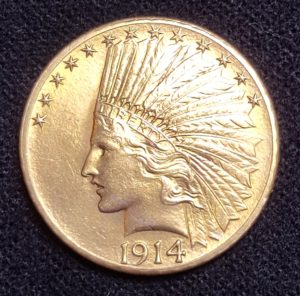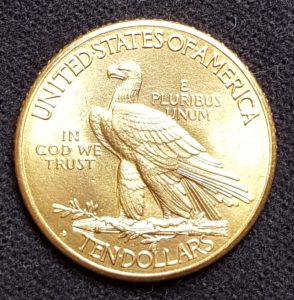1914-D Indian $10 Gold Eagle
Mint: Denver
Mintage: 343,500
Obverse Designer: Augustus Saint-Gaudens
Reverse Designer: Augustus Saint-Gaudens
Composition: Gold
Fineness: 0.9000
Weight: 16.7200g
AGW: 0.4840oz
Diameter: 27mm
Edge: 48 raised stars

Excerpt from MonacoRareCoins:
At the turn of the 20th century, the powerful Theodore Roosevelt was an impassioned champion of America, and believed his country’s superiority should be reflected in its coinage. Going outside the confines of Mint engravers, he solicited the widely-acclaimed artist and sculptor who had created his 1905 presidential inauguration medallion, Augustus Saint-Gaudens, and asked him to redesign America’s gold coinage. The result of that effort were two breakthrough designs for both the ”Double Eagle” $20 Gold Liberty coin and the “Eagle” $10 Gold Indian coin, both of which were introduced with great fanfare in 1907. Collectors across the spectrum hold the $10 Gold Eagle designed by Saint-Gaudens as purely sensational.
In 1904, President Roosevelt was unhappy with the trite Inaugural medal designed by U. S. Mint engravers Charles E. Barber and George T. Morgan. His impassioned interest in numismatic art arose when his artistic friends urged the commissioning of a really innovative Inaugural medal, and suggested the great American sculptor Augustus Saint-Gaudens. The celebrated sculptor agreed, but with his busy schedule, sketched the basic design on a paper napkin, while on the train from Washington. He told Roosevelt that he would entrust the extensive work to his 34 year-old associate, Adolph Weinman, who is better known for his designs for the Mercury Dime and Walking Liberty Half. The medal received widespread acclaim, and Roosevelt went to work to force similarly creative redesign of the nation’s coins on the resentful Chief Engraver of the Mint.
Regular issue coins were struck at all three Mints from 1908 through 1911, and 1914; Only Philadelphia and San Francisco struck eagles in 1912, 1913 and 1915, and only San Francisco struck them in 1916 and 1920. Few Americans noticed the change to 48 stars on the edge in 1912, honoring statehood achieved by Arizona and New Mexico. Coinage throughout the 1920s was very sporadic, representing just four dates: 1926, 1930-S, 1932 and 1933. The Philadelphia Mint struck 312,500 coins in 1933, but released only a few dozen pieces before President Franklin D. Roosevelt’s Executive Order 6260 ended circulation of gold coins and notes. Most 1933 Indian eagles were melted into featureless ingots of .900 fine gold, disappearing with hundreds of thousands of other historic gold coins in the wake of the Presidential directive.
Mint records show that a total of 13,070,583 Indian Head eagles — including proofs — were struck in all. These figures are misleading, as the 1920-S, 1930-S and 1933 coins were melted almost in their entirety. Small hoards of both the `30-S and the `33 have shown up over the years, but none of the `20-S, making this the rarest of the three. Other very elusive dates in mint state are the 1909-D, 1911-D, 1913-S and the 1915-S. In gem condition, all ten Indians are scarce, including the issues most commonly found in mint state, the 1926 and 1932. When grading this design, wear will first appear above the eye and on the cheek of the Indian, and on the reverse, on the top of the eagle’s wing.

